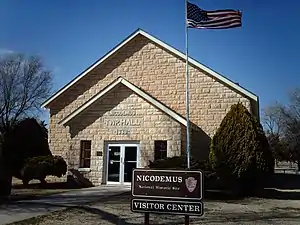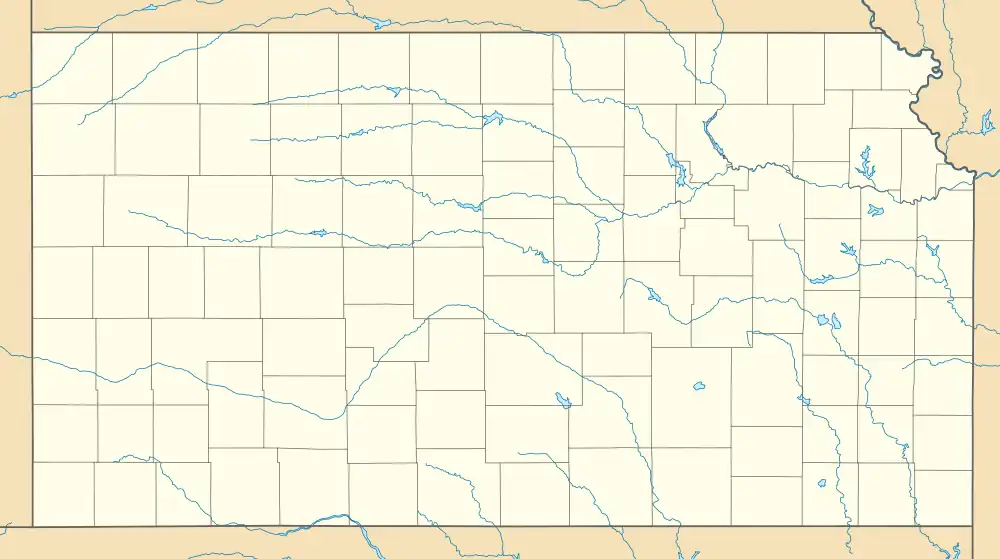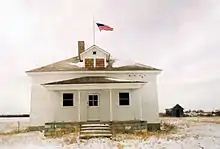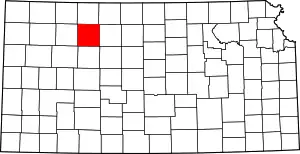Nicodemus, Kansas | |
|---|---|
 Nicodemus Township Hall (2006) | |
 KDOT map of Graham County (legend) | |
 Nicodemus  Nicodemus | |
| Coordinates: 39°23′40″N 99°37′1″W / 39.39444°N 99.61694°W[1] | |
| Country | United States |
| State | Kansas |
| County | Graham |
| Founded | 1877 |
| Named for | Nicodemus |
| Elevation | 2,018 ft (615 m) |
| Population | |
| • Total | 14 |
| Time zone | UTC-6 (CST) |
| • Summer (DST) | UTC-5 (CDT) |
| Area code | 785 |
| FIPS code | 20-50550 [1] |
| GNIS ID | 472219 [1] |
Nicodemus is an unincorporated community in Graham County, Kansas, United States.[1] As of the 2020 census, the population of the community and nearby areas was 14.[2] The community was founded in 1877 and is named for the Biblical figure Nicodemus.[3]
The Nicodemus National Historic Site, commemorating the only remaining western town established by African Americans during the Reconstruction Period following the American Civil War, is in town. During the last weekend of July, former residents and their descendants return for celebrations and parades.
History
Background
The settlement of Nicodemus was part of a greater movement of westward migration that occurred in the latter half of the 19th century. Several technological and cultural factors contributed to the growing trend of movement, enabling and encouraging new groups to move west. The Homestead Act of 1862 provided settlement opportunities for people of modest means. A person could claim a 160-acre plot provided they lived on and develop the land for a 5-year period, after which it could be purchased. In addition, the expansion of the railroad network across the Great Plains increased both the accessibility and economic opportunity of developing settlements.[4]
Kansas also had an appeal to African Americans living in the post-Civil War South. Kansas represented a land of freedom and opportunity due to the actions of John Brown and other abolitionists. Promoters such as Benjamin "Pap" Singleton encouraged African Americans to move to Kansas. Nicodemus would become a destination for these new migrants. Railroads and steamboats offered cheap passage for these early settlers. Eager to escape the persecution and poor living conditions of Reconstruction, thousands left the South and headed west seeking economic opportunity and a sense of freedom.[5]
1877: Foundation
On April 18, 1877, a group of seven Kansans, six of whom were black, established the Nicodemus Town Company. African American W. H. Smith and W. R. Hill, an experienced white land speculator, served as the town's first president and treasurer, respectively.[6] Most of the group consisted of former slaves from Kentucky in search of a new livelihood.[7] The goal was to establish the first all-black settlement on the Great Plains. Two theories explain the choice of the name Nicodemus, one claiming the town was named after the biblical figure Nicodemus, the other holding that the town's name was inspired by the legendary account of an African prince taken into slavery who later purchased his freedom.[7] The location of the town, chosen by Hill, was along the northern bank of the Solomon River, an area suitable for developing farming.[8] The town itself was located on a 160-acre plot, of the 19,200 acres of the township, at large.[4]
Smith and Hill made efforts to promote the town and attract new settlers. Publications describing the resources and benefits of moving to the area were mailed to prospective migrants across the South. Early promotional efforts were directed towards attracting people with enough money to develop the town.[8] Residential lots cost $5 while commercial lots were $75.[4] The promoters charged additional fees for establishing the settlers on the land. Efforts succeeded in bringing groups of colonists from Eastern Kansas and Kentucky, at one point the population reached about 600 people in 1878.[8]
In 1878, John Wayne Niles served as the second president of the colony.[6] The early settlers found life in Nicodemus to be challenging. Some people turned around after seeing the scarcity of resources by mid-1878. Most were very poor farmers who came without money and other provisions. Without proper tools and equipment, such as plows, wagons, and horses, farmers could not efficiently develop the rough land; some resorted to using hand tools to make improvised fields. A lack of timber forced settlers to build homes out of prairie sod. To earn money some people collected and sold Buffalo bones found on the plains; others ventured miles away to work for the railroads.[4] In response to the hardships, townsfolk reached out to other communities, private charities, and even the Native American Osage tribe.
1879–1880: Growth

New groups of settlers arrived in Nicodemus in 1878–79 from Kentucky and Mississippi. Unlike the early migrants, they had the resources necessary to develop and cultivate the farmland; they came with the horse teams, plows, other farm equipment, and money that the early settlers did not have. John W. Niles, a leader in the charity movement, replaced Smith as the president of the town company. Under Niles' leadership, a decision was made to stop seeking charity in order to encourage the ideas of industry and self-sufficiency. Additionally, the town did not want to become a destination of the Exodusters, a migration of thousands of poor black farmers into Kansas. They feared that a mass influx of poor farmers would be harmful to the community.[7]
Soon the town began to grow and businesses became profitable; a hotel and two stores were established and a school and three churches were built. Social organizations such as the Grand Independent Benevolent Society of Kansans and Missouri put on dances and other celebrations for the benefit of the town. One such event was the annual celebration of England's emancipation of slavery in the West Indies.[8] In 1880, the election to determine the Graham County seat was held in Nicodemus, in which the town was defeated in favor of Millbrook.[8]
1880–1888: Decline
After the growth of 1879–80, Nicodemus experienced a period of decline after 1880. Most people who settled in the town did not intend to remain there permanently and subsequently moved on. Not enough of the $75 commercial lots were sold to keep the town growing. Years of poor harvests also contributed to declining population. In 1884, less than 50 people remained in the town. Another challenge Nicodemus faced was a legal battle over the ownership of its land. Henry Miller, a local land speculator, discovered that errors in the filing record meant that the town had not received final ownership of the land. Miller's suit threatened the claims of the residents, but ultimately the case was dropped and the town received its official title on June 6, 1886.[8]
Beginning in 1886 the town began another campaign of promotion. The town's two newspapers: the Western Cyclone and the Nicodemus Enterprise were central to the new campaign. The papers sought to broaden the appeal of Nicodemus by reaching out to other populations, both black and white. Descriptions of the towns numerous social clubs, activities, celebrations, and business opportunities were spread in the hope of attracting new migrants. The town undertook a major effort to bring a railroad route through Nicodemus, passing a vote to sell $16,000 of bonds to finance the projects. Ultimately, none of the three prospective railroad companies (the Missouri Pacific, Union Pacific, and Santa Fe) brought their tracks to the town.[8]
1888–present
The failed attempt to attract the railroad marked the end of growth for Nicodemus and most of the businesses in town relocated elsewhere.[4] Despite the loss of business, the town remained a social center for the local community. Organizations such as the Masons, the American Legion, and the Priscilla Art Club continued to host dances, celebrations, and other events. The annual emancipation celebration continued to be a focal point of town life. In the 1920s, thousands attended the event which consisted of horse races, boxing matches, parades, and baseball games.[7]

The Great Depression and the Dust Bowl each had a serious impact on Nicodemus; the population of the town fell to as low as 40 people. The town did receive aid from the Federal Land Bank and Graham County Farm Bureau. Because of the Depression, many families lost their land and subsequently became tenant farmers. Additionally, the rough conditions of the Depression forced many farmers to change their farming methods, leading many to select more hardy and drought-resistant crops.[7] The declining population led to the closure of the post office in 1953 and the school around 1960. Because of a lack of attendance, the social organizations also closed down.
Starting in the 1970s Nicodemus underwent a process of revitalization and restoration. Donations from former residents led to efforts to repair damage to the deteriorating town buildings. New improvements were made to the town including low-income housing units, construction of a 100-foot tall water tower, and the pavement of the major town streets.[7] These efforts succeeded in preserving Nicodemus and rebuilding its popularity. The town developed a new identity as a retirement destination for former residents.[9] The Emancipation celebration, renamed Homecoming, changed to become a gathering of old residents to celebrate their roots and common history and continues to be celebrated annually.[7]
In 1976, Nicodemus was named a National Historic Landmark. As of 2018, its First Baptist Church, African Methodist Episcopal Church, and other historic buildings were in such poor shape that they could not be opened to the public.[10] The AME Church was successfully renovated and opened to visitors in 2021. At that point, Nicodemus was down to 23 residents.[11]
Geography
According to the United States Census Bureau, the Nicodemus township has an area of 32.4 square miles. The town is located along Highway 24 in the Great Plains.[12]
Climate
Nicodemus's location on the Great Plains entails a four-season climate. Summer is typically long and hot, during which thunderstorms are a common occurrence. Spring and fall are usually brief, while winter is cold. The average annual precipitation is about 22 inches.[13]
| Climate data for Nicodemus, Kansas | |||||||||||||
|---|---|---|---|---|---|---|---|---|---|---|---|---|---|
| Month | Jan | Feb | Mar | Apr | May | Jun | Jul | Aug | Sep | Oct | Nov | Dec | Year |
| Mean daily maximum °F (°C) | 43 (6) |
47 (8) |
56 (13) |
67 (19) |
75 (24) |
86 (30) |
93 (34) |
90 (32) |
82 (28) |
69 (21) |
55 (13) |
43 (6) |
67 (20) |
| Mean daily minimum °F (°C) | 15 (−9) |
18 (−8) |
26 (−3) |
36 (2) |
48 (9) |
58 (14) |
64 (18) |
62 (17) |
51 (11) |
38 (3) |
26 (−3) |
16 (−9) |
38 (4) |
| Source: National Park Service "Climate". National Park Service. Archived from the original on January 7, 2014. Retrieved April 6, 2013. | |||||||||||||
Demographics
| Census | Pop. | Note | %± |
|---|---|---|---|
| 2020 | 14 | — | |
| U.S. Decennial Census | |||
For statistical purposes, the United States Census Bureau has defined this community as a census-designated place (CDP).
Recreation
The National Historic Site is a major tourist attraction in Nicodemus. The Visitor Center includes a bookstore and exhibits of the town's history. Walking and guided tours are available which showcase the historic buildings and features of the town. The Nicodemus Historical Society and Museum operated by descendants offer personal and group history and educational tours to cemeteries, homesteads, and school sites out in the historic township. There is also a roadside park located in the town which includes a playground and a picnic area.[14]
Education
The community is served by Graham County USD 281 public school district.
Notable people
- Edward McCabe (1850–1920), town secretary, later Kansas State auditor
- John Wayne Niles (1842–?), early settler of Nicodemus and the founder of the all-Black Indemnity Party he advocated for slavery reparations in the early 1880s.[15]
- Veryl Switzer (1932–2022), football player for Green Bay Packers, born in Nicodemus 1932
- Lulu Craig (1867-1971), historian and author of unpublished manuscript focusing on the history of Black and Native peoples in Nicodemus
See also
- Nicodemus National Historic Site, containing a history of the town
- Pearl Cleage's play Flying West takes place in Nicodemus in the late nineteenth century.
- History of African Americans in Kansas
References
- 1 2 3 4 5 "Nicodemus, Kansas", Geographic Names Information System, United States Geological Survey, United States Department of the Interior
- 1 2 "Profile of Nicodemus, Kansas (CDP) in 2020". United States Census Bureau. Archived from the original on February 25, 2022. Retrieved February 25, 2022.
- ↑ Kansas Place-Names, John Rydjord, University of Oklahoma Press, 1972, ISBN 0-8061-0994-7
- 1 2 3 4 5 Shaw, Daniel Chu & Bill (1994). Going home to Nicodemus : the story of an African American frontier town and the pioneers who settled it. Morristown, N.J.: J. Messner. pp. 18. ISBN 978-0671887223.
- ↑ Athearn, Robert G. (1978). In search of Canaan : Black migration to Kansas, 1879–80. Lawrence: Regents Press of Kansas. p. 6. ISBN 978-0700601714.
- 1 2 "Nicodemus in its Infancy". The Western Cyclone. April 21, 1887. p. 10 – via "U.S., African American Newspapers, 1829-1947" database.
- 1 2 3 4 5 6 7 United States. National Park Service. Rocky Mountain Regional Office (1986). Promised land on the Solomon: Black settlement at Nicodemus, Kansas (PDF). U.S. Dept. of the Interior, National Park Service, Rocky Mountain Region.
- 1 2 3 4 5 6 7 Hamilton, Kenneth Marvin (1991). Black towns and profit : promotion and development in the trans-Appalachian West, 1877–1915. Urbana: University of Illinois Press. ISBN 978-0252017575.
- ↑ Taylor, Quintard; Ravage, John W. (2008). Black pioneers : images of the Black experience on the North American frontier (2nd ed.). Salt Lake City, Utah: University of Utah Press. p. 102. ISBN 9780874809411.
- ↑ Edwards, Richard (July 5, 2018). "The disappearing story of the black homesteaders who pioneered the West". Washington Post. Retrieved July 8, 2018.
- ↑ Eckels, Carla; McIlwain, Katelynn (September 23, 2021). "Nicodemus Celebrates Heritage With 143rd Homecoming". KMUW. Retrieved January 27, 2022.
- ↑ "Directions". National Park Service. Retrieved April 8, 2013.
- ↑ "Climate". National Park Service. Archived from the original on January 7, 2014. Retrieved April 8, 2013.
- ↑ "Plan Your Visit". National Park Service. Retrieved April 8, 2013.
- ↑ William A. Darity, Jr. (2021). Ibram X. Kendi; Keisha N. Blain (eds.). Four Hundred Souls. New York. pp. 245–246. ISBN 9780593134047.
{{cite book}}: CS1 maint: location missing publisher (link)
Further reading
- Craig, Lula S. "A History of Nicodemus: Graham County, Kansas." Kenneth Spencer Research Library, University of Kansas.
- Crockett, Norman I. The Black Towns. Lawrence: Regents Press of Kansas, 1979.
- Hamilton, Kenneth Marvin. Black Towns and Profit: Promotion and Development in the Trans-Appalachian West, 1877–1915. Urbana: University of Illinois Press, 1991.
- Hamilton, Kenneth Marvin. "The Origins and Early Promotion of Nicodemus: A Pre-Exodus, All-Black Town." Kansas History 5 (winter 1982): 220–242.
- Promised Land on the Solomon: Black Settlement at Nicodemus, Kansas. Washington, D.C.: U.S. Department of the Interior, National Park Service, Rocky Mountain Region, n.d.
- Schwendemann, Glen. "Nicodemus: Negro Haven on the Solomon." Kansas Historical Quarterly 29 (spring 1963): 10–31.
- Shaw, Bill & Daniel Chu. Going home to Nicodemus: The story of an African American frontier town and the pioneers who settled it. Morristown: Silver Burdett Press, 1994.
- Shortridge, James R. Peopling the plains: Who Settled Where in Frontier Kansas. Lawrence: University Press of Kansas, 1995
- Athearn, Robert G. In Search Of Canaan: Black Migration to Kansas 1879–80. Lawrence: Regents Press of Kansas, 1978
- Ravage, John W. Black Frontiers: Images of the Black Experience on the North American Frontier. Salt Lake City: University of Utah Press, 1997.
- Hinger, Charlotte. The Healer's Daughter. Gale Cengage Learning, 2019.
External links
- Nicodemus National Historic Site
- Nicodemus Photo Tour
- Kansas State Historical Society, Portrait of Nicodemus
- A history of Nicodemus, Graham County, Kansas
- Nicodemus: Negro haven on the Solomon - 1971
- 1877 Historic Flyer
- Edwards, Richard (July 5, 2018). "The disappearing story of the black homesteaders who pioneered the West". Washington Post. Retrieved July 8, 2018.
- Graham County maps: Current, Historic, KDOT
